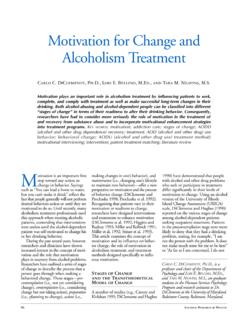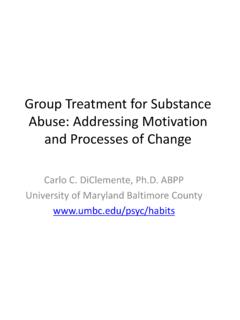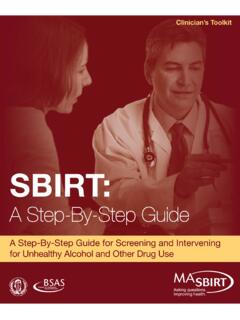Transcription of Routes to Recovery - GOV.UK
1 1 Routes to Recoveryvia the communityMapping user manualIntroductionChapter OneChapter ThreeChapter FiveChapter SixChapter TwoChapter FourTechniques and tools to enhance assessment and build a plan for recoverypages 9 - 49 Outline of the manualpages 3 - 8 Setting, achieving and rewarding goalspages 50 - 56 Building social support for changepages 57 - 70 Providing information to reduce harmpages 71 - 77 Skills developmentpages 78 - 93 Exiting treatment and aftercarepages 94 - 104 AcknowledgmentsDeveloped by Dr Ed DayContributions: The TCU team, Luke Mitcheson, Kieran Lynch, Steve Taylor, Christopher Whiteley3introductionCore elements of treatmentThe importance of Recovery Recovery is an organising principle that guides effective treatment services. A number of key principles are useful to keep in mind when planning professional treatment interventions.
2 - People do recover, but addiction comes with a high level of stigma - hope is a key message to instil in every client - Addiction is a complex social problem professional treatment cannot provide all the solutions - People seek professional treatment when their problem severity exceeds their personal resources for Recovery building Recovery capital facilitates autonomy and re-integration into the community - Recovery can only happen from a strong base risk reduction may be an important early goal - Recovery is based on the power of community the more people are helping you, the more likely you are to succeed - Successful treatment empowers clients to take control of their lives 4 Achieving a lot using many small Problem drug use has many components: genetics, early up-bringing, mental health, personality and life events.
3 No single approach will address everything simultaneously Many different psychosocial approaches to helping an individual control substance use have been described and shown to be effective in certain populations at certain times motivational interviewing , 12-step mutual self-help, cognitive behavioural therapy, contingency management, and social/family interventions It has often proved difficult to deliver any of these interventions in their entirety due to size of caseload, or the limited availability of training or supervision This package therefore starts with some common components of effective treatment described by Moos (see next slide), and uses the concept of Node-Link Mapping to support the delivery of these techniques in session-sized chunksMoos R (2007) Theory-based ingredients of effective treatments for substance use disorders.
4 Drug and Alcohol Dependence 88(2-3) 109-1215 Common components of effective treatment (Moos 2007)Support, structure & goal direction Quality of client-therapist alliance associated with improved outcome Therapists who have an underlying theory of treatment, supported by supervision, experience better outcomes More emphasis on goals and greater organisation associated with better outcomesRewards & rewarding activities Rewards during treatment for remaining substance-free Planning for a generally more rewarding lifestyle Abstinence-oriented norms & models Accepting abstinence-oriented norms and learning from abstinent role models Use role models to help monitor and support abstinence Normative feedback about substance use and consequencesSelf-efficacy & coping skills Build self-efficacy and skills to manage high-risk situations and life stressors + obtain rewards that are an alternative to substance use Use group/network interactions to provide opportunities for sober behaviour leading to improvements in coping and self-efficacy Aims to increase self-efficacy by
5 Drawing out personal solutionsCommon components of effective treatment6 The key task in the early stages of effective treatment is building a therapeutic alliance with the client. Use of a motivational style of interviewing is recommended, and consideration should be given to the correct balance of following, guiding and directing in using any of these tools [SECTION 1a] Therapeutic work is most effective when there is structure and goal direction. Node-link mapping is a useful technique to provide structure, and is the organising principle of this manual [SECTION 1b] By using a guiding interviewing technique, and use of node-link mappings to structure and feedback information collected from a variety of sources, the therapist can emphasize both strengths and deficits, and contrast these with the client s desired life goals [SECTION 1c] The therapist can then work with the client to set effective, SMART goals for the aspects of their life that are most important to them [SECTION 1d] Helping the client to build social support for change can help them achieve goals and play a part in rewarding progress [SECTION 1e]
6 A Recovery -oriented treatment system builds from the bottom up, and it is important to attend to minimising any risks whilst positive change is occurring [SECTION 1f]. Effective provision of information is important [SECTION 4] Once goals have been set, goal achievement can be rewarded [SECTION 2] Social support may come from the client s immediate social network (friends, family etc) or may come from mutual self-help groups [SECTION 3] Positive role models in the support network can provide helpful feedback about substance use and its consequences Tackling goals and building social support will enhance self-efficacy, but may also provide evidence of skills deficits such as ineffective communication, poor planning or impulsivity. Skills training exercises using homework and feedback can address these deficits, further building self-efficacy and autonomy [SECTION 5] As the client s confidence builds and they feel more empowered to make changes in their life, more emphasis is placed on using their new found skills and social support to plan for increasing independence and life without drugs [SECTION 6]Outline of the manual71d.
7 Setting goals2. Setting, achieving and rewarding goals1c. Describing strengths and deficits5. Skills development1f. Managing risks and problems4. Providing information to reduce harm1e. Social support for change3. Building social support for change3a. Social network3b. Mutual help groups1. Techniques and tools to enhance assessment and build a plan for recovery6. Building and maintaining Recovery in the community1a. motivational interviewing1b. Node link mapping89oneEnhancing the assessment process and building a plan for Recovery 1a. Using motivational interviewing 1b. Using node-link mapping 1c. Describing strengths & deficits 1d. Setting goals 1e. Building social support for change 1f. Managing risks & problemsContents of this section:1a. Using motivational interviewing10 motivational interviewing motivational interviewing is a well researched style of professional healthcare communication used to support efforts to change behaviour Clients entering drug treatment usually have some degree of ambivalence about their use.
8 motivational interviewing focuses on exploring and resolving this ambivalence drawing the clients own reasons for change, or intrinsic motivation The key task is to help the client to notice the difference between what they are doing now and how they would like to be. The awareness of the difference between these two positions is used to help the client move towards making changes This is not achieved by telling the client what to do, or offering expert opinion. The therapist aims to elicit self- motivational statements from the client, then feed them back as part of the process of building towards change A key aim of these sessions is to instil in the client the belief that they can change. In many cases this will lead to positive action without any directive work from the therapistSEE Miller W & Rollnick S (2002) motivational interviewing : Preparing People for Change.
9 New York: The Guilford PressRollnick S, Miller W & Butler C (2008) motivational interviewing in Health Care: Helping Patients Change Behavior. New York: The Guilford Press11 motivational interviewingASKING: Open ended questionsLISTENING: Capture client s words with brief summaries or reflective listeningINFORMING: Ask permission before giving advice; first elicit client s knowledge, then provide information. Explore reactions to the informationAGENDA SETTING: What to change? Invite client to select an issuePROS AND CONS: Why change? Invite patient to consider next stepsIMPORTANCE & CONFIDENCE: Why and how? Enables intervention to be targeted. Scaling questions may be usefulIdentification of and selective use of change statements in summaries and reflectionsAdopt a guiding communication styleAdd strategies to elicit change talkRespond appropriately to change talkNot the same as directing or followingAct as a well informed guide, engaging and collaborating with the client but emphasizing their autonomy People believe what they hear themselves say Pay special attention to any change statements you have heard.
10 Ask if the client is ready to make the change and how you can help 121b. Using node-link mapping13 What is node-link mapping?Main parts of a node-link map:A node is an idea captured in a box, circle, or other shapeA link (named or not) shows the relationship between nodesFor example:For example: An example of a blockbuster film is Star Wars Node-link mapping is a simple technique for presenting verbal information in the form of a diagram, which has been shown to have positive benefits for keyworking interactions It was first studied as a tool for helping students take better notes during lengthy college lectures. Displaying information visually appears to help us understand things better and recall key ideas (hopefully when we need them). This is summarised in the old adage a picture is worth a thousand words Node-link mapping can also be used to enhance any interaction with a client, irrespective of the therapeutic technique or strategy being used Dansereau DF & Simpson DD (2009) A Picture is Worth a Thousand Words: The Case for Graphic Representations.


















